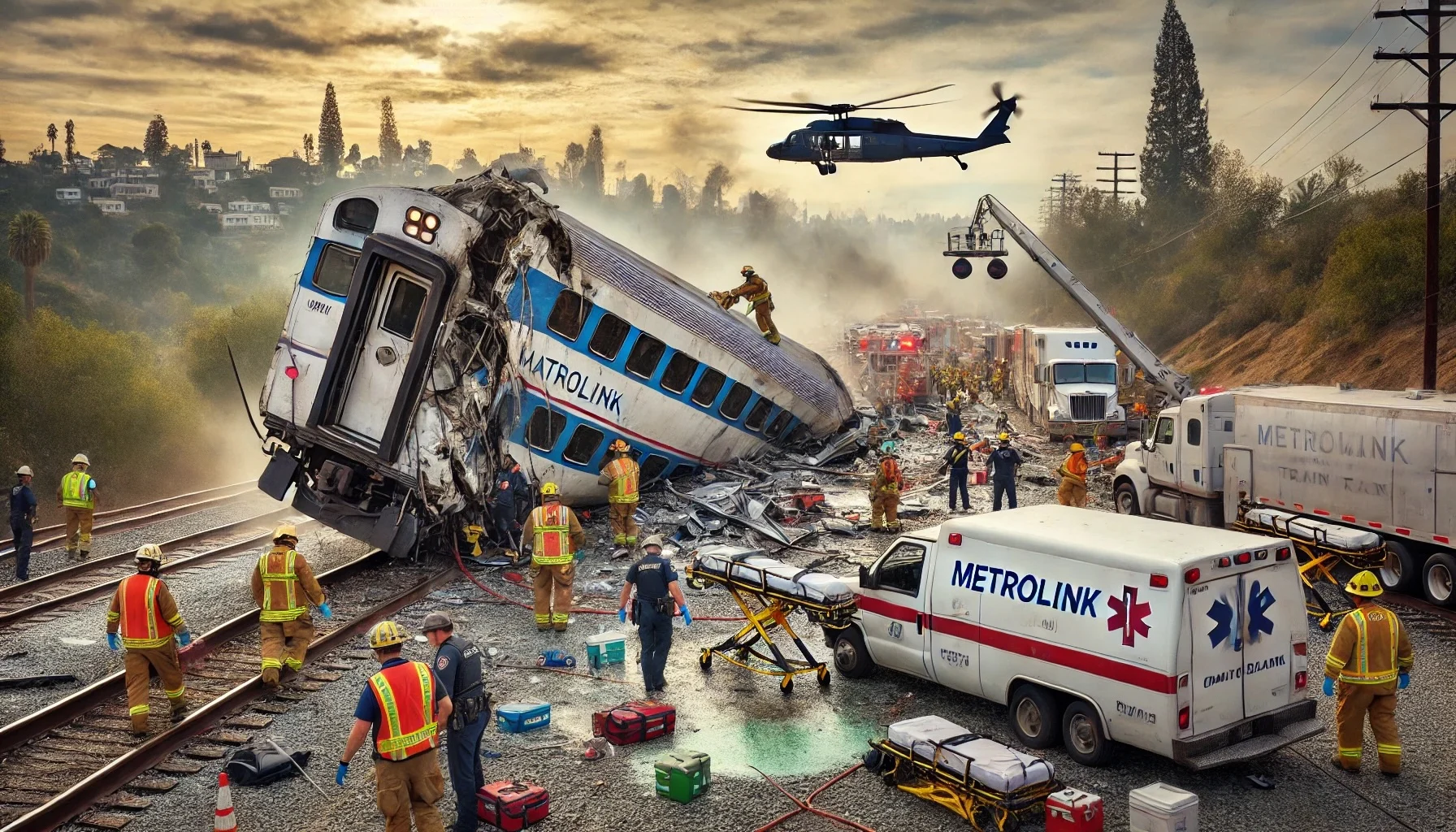
The 2008 Chatsworth Train Collision
by: The Calamity Calendar Team
September 12, 2008
A Routine Ride Turns Tragic
Friday afternoons in Los Angeles are always busy, and for the 225 passengers on Metrolink train 111, the trip started out as a typical commute. The train, headed from Union Station toward Moorpark, moved swiftly through the city and suburbs, carrying people eager to start their weekend. However, as the train approached Chatsworth, 30 miles from downtown Los Angeles, a disaster loomed that no one on board could have foreseen.
At the controls of Metrolink 111 was Robert M. Sanchez, an experienced engineer. However, unbeknownst to passengers, Sanchez was distracted—a dangerous oversight on what was otherwise a clear, sunny day. Just minutes before reaching the single track section north of Chatsworth, where freight and passenger trains share the same line, Sanchez missed a critical red signal. That signal was supposed to stop Metrolink 111 and let a Union Pacific freight train traveling in the opposite direction pass safely.
In a terrible twist, Sanchez was preoccupied with sending text messages, including one to a teenage rail enthusiast, just moments before the collision. Despite clear rules prohibiting cellphone use, this tragic distraction led him to miss the life-saving red light.
The Moment of Impact
At 4:22 PM, the inevitable happened. The Metrolink train, traveling at 43 mph, collided head-on with the massive Union Pacific freight train. The force of the impact telescoped the front Metrolink car over the freight engine, compressing it like an accordion. The noise was deafening as metal twisted, and passengers were thrown violently from their seats.
In the aftermath, 25 passengers lay dead, including Sanchez himself. The scene was a nightmare: bodies trapped in the wreckage, while those who survived faced severe injuries ranging from broken bones to life-threatening trauma.
Response and Rescue
Emergency responders arrived within minutes. Firefighters, paramedics, and police quickly moved to extract survivors from the wreckage, a process that would take hours. Helicopters flew over the scene, airlifting critically injured passengers to hospitals across the city. Makeshift triage centers were set up near the crash site as local hospitals became overwhelmed with victims.
Thanks for subscribing!
Rescuers described the scene as one of the worst train accidents in California history. Some passengers, though badly injured, managed to climb out of the twisted cars, while others remained pinned and waited for rescue workers to cut through the debris.
A Preventable Tragedy
As investigators from the National Transportation Safety Board (NTSB) arrived, the scale of the disaster became clear. Investigations revealed that had Sanchez obeyed the red signal, the collision would have been avoided. The NTSB's findings sparked outrage across the nation as it was discovered that Sanchez had sent 45 text messages that day, including one just 22 seconds before the crash.
The Chatsworth tragedy drew attention to the dangers of human error and highlighted a significant flaw in the rail system’s safety measures. Up until then, train operations relied almost exclusively on human observation to prevent accidents. But, as this accident showed, even a momentary distraction could have devastating consequences.
Positive Train Control and a Push for Safety
The Chatsworth collision became a turning point for U.S. rail safety. In response, Congress passed the Rail Safety Improvement Act of 2008, which mandated the installation of Positive Train Control (PTC) systems on major rail lines across the country.
PTC is a sophisticated, computer-controlled system designed to automatically stop trains if an operator misses a signal, is speeding, or risks a collision. While there had been discussions about implementing such technology before, it took the catastrophic loss of life in Chatsworth to push lawmakers into action.
Despite the urgency, implementing PTC was slow and expensive. Originally mandated for full deployment by 2015, the deadline was extended to 2020. Even with delays, this technological advancement represented a massive step toward preventing similar accidents in the future.
Lingering Impact and Legal Battles
In the wake of the crash, lawsuits were filed against Metrolink, and in 2010, a settlement of $200 million was reached—the maximum allowable under federal law. Victims and their families argued that the cap was woefully inadequate given the loss of life and severe injuries suffered by many survivors.
The tragedy also forced California to pass a law banning the use of cell phones by train engineers, something that seemed obvious in hindsight but wasn’t strictly regulated before. Nationwide, the accident raised awareness about the dangers of distracted driving, not just on trains but in all forms of transportation.
A Legacy of Change
The Chatsworth train collision remains one of the deadliest train accidents in modern U.S. history. It serves as a chilling reminder of the tragic consequences of human error and distraction. While safety systems like Positive Train Control now monitor train movements to prevent similar accidents, for the families of the victims, the legacy of Chatsworth is one of loss.
Today, a memorial stands near the crash site in honor of those who lost their lives. It’s a place for reflection—a solemn reminder that while technology can help prevent future disasters, the cost of waiting too long to act can be devastating.
Stay in the Loop!
Become a Calamity Insider and get exclusive Calamity Calendar updates delivered straight to your inbox.
Thanks! You're now subscribed.